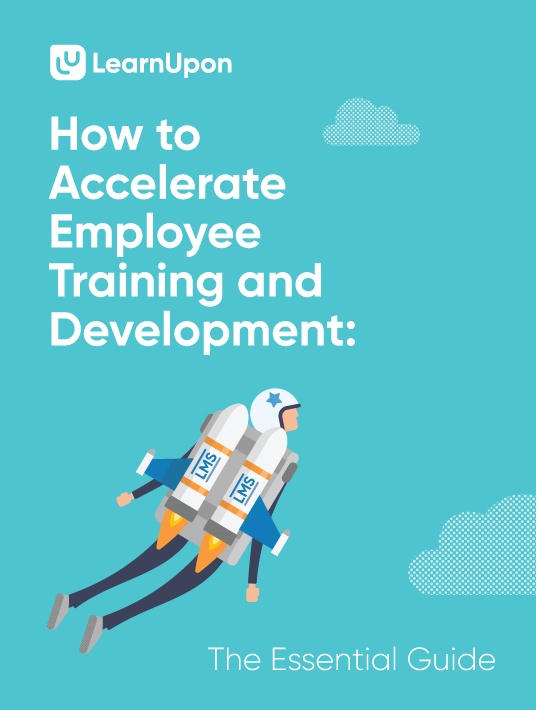The Impact Of Training And Development On Your Business
Although training and development are more feasible than ever, that doesn't mean it's being fully adopted by organizations. In reality, there’s still a sizeable disconnect between what businesses should be doing and what training is actually happening and it’s hurting their growth. Workforce training has repeatedly proven to have real benefits for businesses that can’t be ignored. If you’re part of an organization that’s considering or planning to ramp up its learning efforts, now is the time. Here are 8 points that prove the importance of training and development in the corporate environment.

1. Productivity And Performance
The overarching goal of most employee training and development strategies is to improve employee productivity. Research shows that it significantly impacts it. A recent study found that 84% of employees within the best performing organizations are receiving the training they need. When we compare this to only 16% in the worst performing companies, it’s clear that it really can make or break your organization’s rate of success. There are numerous reasons why the disparity is so wide. Critically, training and development allows employees to successfully fulfill their roles by:
- Giving each employee a thorough understanding of what’s expected of them. They’re clear on their goals and role in the team and wider organization.
- Getting access to the tools or resources they need to perform their role.
- Providing them with the most up-to-date information and knowledge needed to be a successful team member.
2. Onboarding Optimization
Hiring new team members is an investment. It takes time, money, and resources, but when done well it impacts everything from productivity to customer success to retention, and more. So, the last thing your business wants or needs is for all of this energy to go to waste. But, it often does. With companies on average losing 25% of all new hires within a year, it’s a process that needs refinement. Training and development streamlines the onboarding process and enhances its likelihood of success, particularly when done with an LMS. Your business can pre-plan all of the training and development a new employee needs, from learning about your company culture to the tools you use to the goals you expect them to meet. Through this definition, you can create a dynamic path for onboarding. Once implemented you can add your users to your LMS and set them on the road to success.
3. Employee Retention
Study after study, report after report, each one tells us that training and development is one of the key factors in employee retention - a critical metric for your company. Organizations that place emphasis on learning boast retention rates of around 30-50% higher than those that don’t [1] - that’s a substantial number! What's more, employees recognize the significance of training and development. In fact, a 2018 study shows that 94% of employees cite investment in training and development as a key reason to stick around in their role for longer [2]. This means reduced hiring costs, less time-consuming onboarding, an increase in opportunities to hire from within and a happier workforce - all significant wins for your business.
4. Formalize And Structure Knowledge Share
Consistency is a universal issue for organizations. How do you maintain the same high standards as you grow? Employee learning and development tackles this problem head-on. From day one every employee and every team is given the same formalized training, on topics such as company policies, health, and safety, etc. They all have a baseline education in resources, tools to use and goals to achieve. This reduces any knowledge disparities and ensures equal footing and knowledge share across your workforce.
5. Customer Satisfaction
Happy customers fuel business growth. They strengthen your brand, provide positive word of mouth, contribute to higher NPS scores, create advocates and do much more. Training all your teams, especially customer-facing teams, gives you a competitive advantage. Each employee has the tools and resources they need to serve customers at the highest level. They now have access to the knowledge that will enable them to provide a quality experience to every customer.
6. Employee Engagement
Employee engagement provides your workforce with an environment that enables them to perform to the best of their abilities. It not only leads to happier employees, but it also impacts retention, performance and profit margins. High employee engagement incorporates a wide range of factors, with one of the most important being learning and development. Providing training helps boost employee engagement. A recent study discovered that 42% of L&D professionals stated that employees who were highly engaged in learning were also highly engaged in the organization overall [3].
7. Internal Weaknesses
Every organization has internal weaknesses, some you’re aware of and some you aren't. Security issues, skill gaps, organizational structures... these are all potentially damaging pain points. Proper training helps your business overcome so many of these internal problem areas. You’re also providing information to your employees that helps safeguard you from any potential issues in the future. Another plus is that it encourages knowledge sharing within your organization. Your employees learn from past mistakes and recurring issues, shielding your business from potential errors that might come down the line.
8. Track Employee Skills
One struggle businesses experience is recording what skills employees are gaining on the job. With no easy way to measure and record training, it's cumbersome to track. Through eLearning, especially with an LMS, every course and skill that your employee acquires is tracked, from onboarding to upskilling. You have reports that clearly show whether your employees are up-to-date with their training. You also can provide employees with the opportunity to upskill so they’re always improving.
Training And Development: The Next Step For Your Business
Implementing or improving your employee training may be on your roadmap, a task to be done down the line, but why wait? Its positive effects will ripple throughout your organization and with modern software, it’s never been easier, and more attainable for you to achieve. Download the eBook How to Accelerate Employee Training and Development to perfect the implementation and overall improvement of Training and Development - discover how you can create a successful training strategy for your business.
For those interested in learning even more, at a more advanced level you should really check out this webinar. It is brought to you by LearnUpon and tells you everything you need to know to make your employee training sound and appealing.
References:
- U.S. L&D Report: 2018: Benchmark Your Workplace Learning Strategy
- 2018 Workplace Learning Trends
- Employers fear 4.5m workers could be on the move this year









